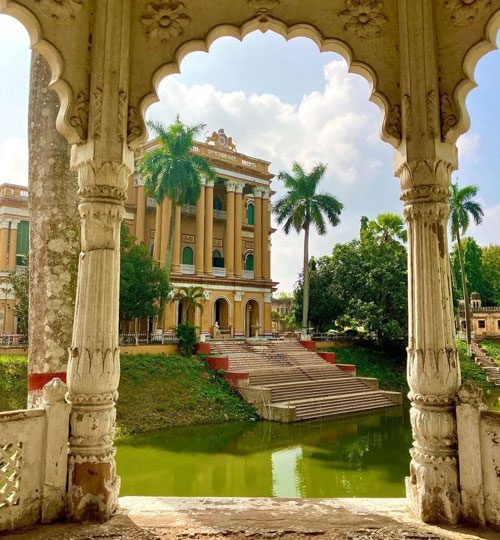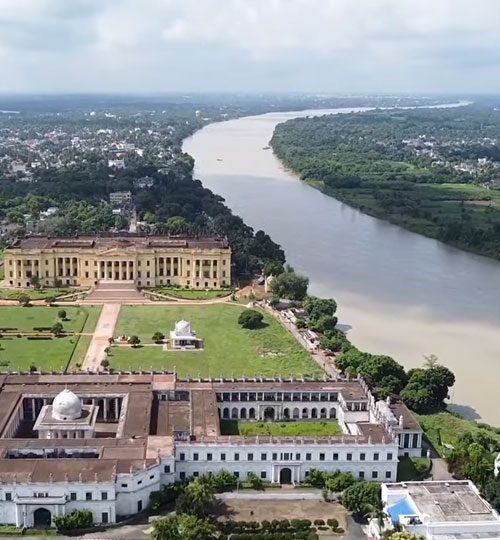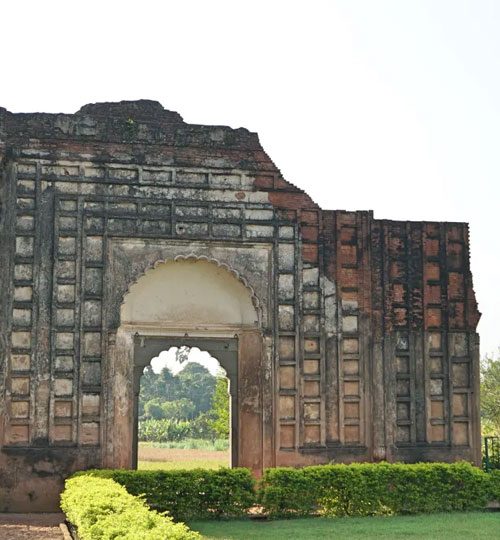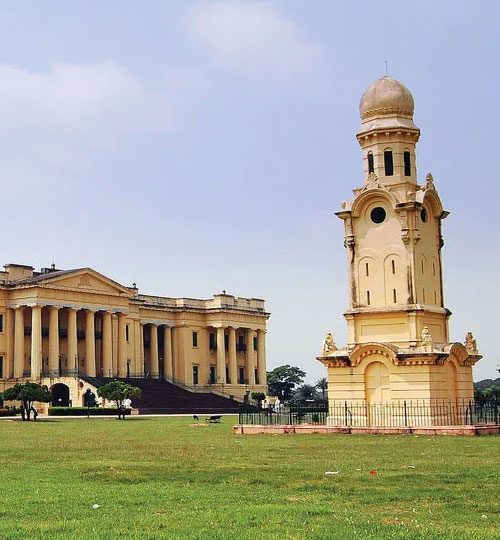Murshidabad
Murshidabad is a historic place in Bengal. The place is about 200 km North of Kolkata, the capital of the state. Murshidabad is the name of the district as well as the city which is the district headquarters. The town is located on the east bank of the Hooghly River, which is a distributor of the river Ganga. The place is famous as a historic place which saw the rise of the beginning of British dominance in India.
Reachng Murshidabad
Kolkata Airport (Netaji Subhas Chandra Bose International Airport) is the nearest airport which is connected to the rest of the country as well as many places across the world. From Kolkata, you can either drive to Murshidabad or reach there by train. If travelling by car, it may take about 5 hours to cover the distance of roughly 200 km. Trains are a faster mode of transport and may take between 3.5 to 4.5 hours. There are about 9 trains connecting the two cities daily.




History
The history of Murshidabad is closely linked to Southern India. In the late 17th century a Persian merchant, Haji Shafi Isfahani, bought a slave from a Brahmin family in the South. Haji Isfahani not only gave food and shelter to him but also provided education to the slave. He was converted to Islam and his new name was Mirza Hadi who eventually joined the Mughals. He was a brave man who soon was included in the good books of Aurangzeb the emperor. His honest service to the Mughal emperor earned him the post of Diwan at Dacca in Bengal. In the year 1703, he shifted his base from Decca to Murshidabad. It was a prosperous place on the banks of the river Bhagirathi (Hoogly). Aurangzeb honoured him with the title of “Murshid Quli Khan”. And the place was named after him as Murshidabad. Murshid himself changed the name of the place with the permission of Aurangzeb. Murshid Quli became the Nawab of Bengal and established himself as one of the ablest and most influential rulers in contemporary India. After him, his son-in-law Suja- Ud- Daulla ruled the region till 1739. Then Suja’s son Sarfaraz Khan came into power. But soon Nawab Nazim of Bihar Alivardi Khan defeated Sarfaraz Khan in the war and became the new Nawab. Alivardi ruled between 1740 to 1756. He too was known for his able administration. Under his regime, Murshidabad flourished to its height. After him, his grandson Siraj-Ud-Daulla became the ruler. Meanwhile, the British East India Company with its mighty ambition was a potential threat to Siraj. They confronted in the ’Battle Of Plassey‘ and Siraj was ultimately defeated by the British with the help of a few traitors and Siraj was killed. The following Nawab except for Mir Qasim was mainly puppet rulers of the British. Murshidabad started losing its importance and grandeur. The condition of the Nawab of Bengal deteriorated and Kolkata came up as the major city of Bengal and thus soon became the capital of British India. Murshidabad is currently a small town but its old buildings, Mosques, and Palaces remind us of its glorious past the town witnessed the dramatic events of India which shaped the country.
Places to Visit
Hazarduari Palace – It is the major attraction of Murshidabad. Hazarduari is probably the most remarkable building in eastern India as far as architectural beauty and elegance are concerned. It was built by Nawab Humayun Jah between 1829-37. This building is situated on the eastern bank of the river Bhagirathi. The palace has 1000 doors (out of which 900 are real and the rest are false doors) and this is the reason the palace has been named Hazarduari. The chief architect of this magnificent building was Colonel Dunkan Macleod of the Bengal Corps. This outstanding three-storied structure has more than 114 rooms and 8 galleries. The palace is now converted into a museum and maintained by the Archaeological Survey of India (ASI). The museum displays some wonderful oil paintings made by well-known European artists, portraits of the Nawabs, statues, rare maps and books, a huge collection of weapons, mirrors, Ivory works, and other Artifacts.
Important Info – Hazarduari is closed on Friday. Entry timing is from 10 am to 5 pm.
Katra Mosque – The brick-built Katra Mosque is one of the major attractions of the town. This Magnificent structure was built by an architect named Murad Farash in one year only. It was built by the order of Nawab Murshid Quli Khan between 1723-24. The mosque used to have 4 giant towers. Now only two of these huge towers exist. Despite being severely affected by the earthquake of 1897, the structure still retains the beauty of its past. The unique feature of the Mosque is its row of double-storied domed cells cloister. The mosque has five doors and a huge courtyard which can accommodate nearly 2000 people offering Namaz. The Mosque houses the grave of Murshid Quli Khan. There is a Shiva temple inside the mosque complex. The mosque is maintained by ASI now.
Jahan Kosha – This great Gun is known as ’Jahan Kosha’ or the world subduer. To the southeast side of the Holly Katra Mosque in Murshidabad lies this huge cannon. It was made in the year 1637, during the time of Shah Jahan. It measures 5.5 m in length and weighs more than 7 tons. This was made by a Bengali blacksmith called Janardan Karmakar in Dhaka. Though it has been kept in the open for more than 350 years, there is hardly any patch of rust on it.
Moti Jheel – Another historical treasure is this lake situated south of Lal Bagh. This horseshoe-shaped lake has within its vicinity a stone palace, a Mosque, a gateway, and a few other structures. The mosque is known as the ’ Kala Masjid’. Moti Jheel was also known as Company Bagh as it was occupied by the East India Company after the battle of Palashi.
Chowk Masjid – This is one of the most beautiful structures in Murshidabad. Built by Munny Begum, the wife of Mir Zafar in the year 1767, it is a well-maintained and well-decorated structure. Once the main market (chowk) of the city used to be in this place and the Mosque thus acquired its name.
Nizamat Imambara – Located bang opposite the Hazarduari Palace, this is the largest Imambara (congregation hall) in Bengal. Built-in the year 1847 by the son of Nawab Humayun Jah, Mansur Ali Khan Feradun Jah, after the original Imambara built by Siraj was damaged by fire. This beautiful Immambara can be accessed by the public only during the Muharram festival.
Madina of Siraj – It is situated between the Hazarduari Palace and the Imambara. This is a small mosque with beautiful design and decoration. It is called Madina because it has a replica of Hazrat Muhammad’s tomb at Madina.
Zurud Mosque – Situated on the banks of river Bhagirathi and opposite the gate of the palace. It is popularly known as the yellow mosque as the building is painted in yellow.
Wasef Manzil – Nawab Wasef Ali Mirza ordered the construction of this palace. This magnificent building is close to the Hazarduari Palace. In the earthquake of 1897, this palace was damaged and once again rebuilt in the year 1904.
Namak Haram Deorhi – It is located opposite Jafarganj cemetery. It was the residence of Mir Jafar. He used to stay here before he became the Nawab. The palace no longer exists only a big gate (Deorhi) still stands. Due to the treachery of Mir Jafar, it was named Namak Haram (Traitor) Deorhi.
House of Jagat Seth – Jagat Seth is a title given to one of the descendants of Manik Chand, the original banker or financial advisor of Murshid Quli Khan. The word Jagat Seth means the banker of the world. This house is the banking premises of the Jagat Seths. Currently, a guided tour is arranged inside the house.
Khosbagh – Tourists can enjoy a cruise on country boats and can reach the other side of the river. Khosbagh contains the family graves of Nawab Siraj–Ud–Daulah.
Kiriteshwari Temple – It is one of the 51 Saktipithas and a very famous temple. Distance is less than 10 km from Khosbagh.
